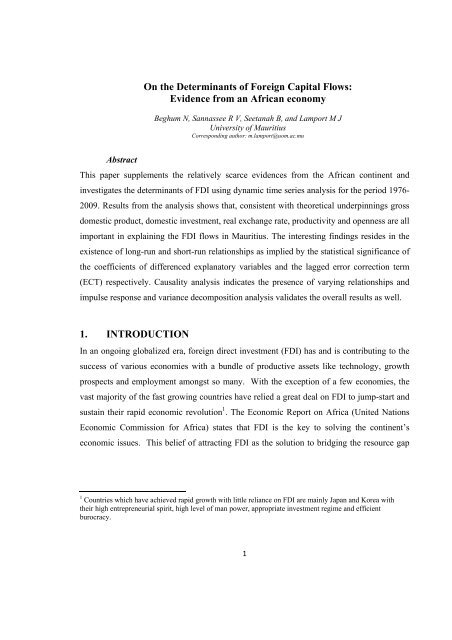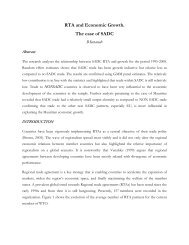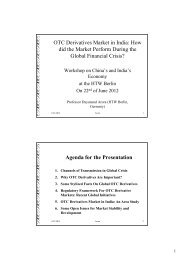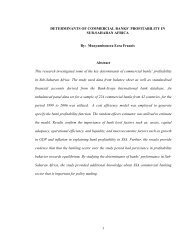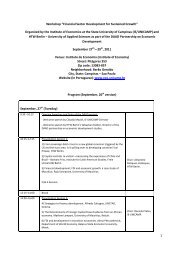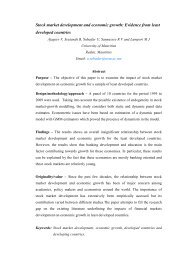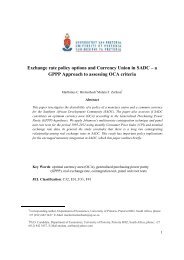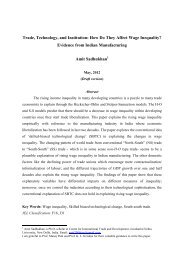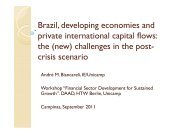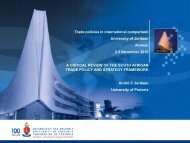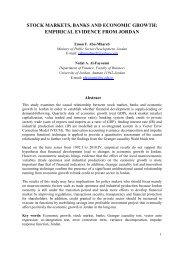On the Determinants of Foreign Capital Flows - DAAD partnership ...
On the Determinants of Foreign Capital Flows - DAAD partnership ...
On the Determinants of Foreign Capital Flows - DAAD partnership ...
You also want an ePaper? Increase the reach of your titles
YUMPU automatically turns print PDFs into web optimized ePapers that Google loves.
<strong>On</strong> <strong>the</strong> <strong>Determinants</strong> <strong>of</strong> <strong>Foreign</strong> <strong>Capital</strong> <strong>Flows</strong>:<br />
Evidence from an African economy<br />
Beghum N, Sannassee R V, Seetanah B, and Lamport M J<br />
University <strong>of</strong> Mauritius<br />
Corresponding author: m.lamport@uom.ac.mu<br />
Abstract<br />
This paper supplements <strong>the</strong> relatively scarce evidences from <strong>the</strong> African continent and<br />
investigates <strong>the</strong> determinants <strong>of</strong> FDI using dynamic time series analysis for <strong>the</strong> period 1976-<br />
2009. Results from <strong>the</strong> analysis shows that, consistent with <strong>the</strong>oretical underpinnings gross<br />
domestic product, domestic investment, real exchange rate, productivity and openness are all<br />
important in explaining <strong>the</strong> FDI flows in Mauritius. The interesting findings resides in <strong>the</strong><br />
existence <strong>of</strong> long-run and short-run relationships as implied by <strong>the</strong> statistical significance <strong>of</strong><br />
<strong>the</strong> coefficients <strong>of</strong> differenced explanatory variables and <strong>the</strong> lagged error correction term<br />
(ECT) respectively. Causality analysis indicates <strong>the</strong> presence <strong>of</strong> varying relationships and<br />
impulse response and variance decomposition analysis validates <strong>the</strong> overall results as well.<br />
1. INTRODUCTION<br />
In an ongoing globalized era, foreign direct investment (FDI) has and is contributing to <strong>the</strong><br />
success <strong>of</strong> various economies with a bundle <strong>of</strong> productive assets like technology, growth<br />
prospects and employment amongst so many. With <strong>the</strong> exception <strong>of</strong> a few economies, <strong>the</strong><br />
vast majority <strong>of</strong> <strong>the</strong> fast growing countries have relied a great deal on FDI to jump-start and<br />
sustain <strong>the</strong>ir rapid economic revolution 1 . The Economic Report on Africa (United Nations<br />
Economic Commission for Africa) states that FDI is <strong>the</strong> key to solving <strong>the</strong> continent’s<br />
economic issues. This belief <strong>of</strong> attracting FDI as <strong>the</strong> solution to bridging <strong>the</strong> resource gap<br />
1 Countries which have achieved rapid growth with little reliance on FDI are mainly Japan and Korea with<br />
<strong>the</strong>ir high entrepreneurial spirit, high level <strong>of</strong> man power, appropriate investment regime and efficient<br />
burocracy.<br />
1
has been reinforced by <strong>the</strong> experience <strong>of</strong> a small number <strong>of</strong> fast growing East Asian newly<br />
industrialized countries 2 .<br />
In Mauritius, FDI has played a critical role in <strong>the</strong> industrial diversification, employment<br />
creation, export development and growth <strong>of</strong> <strong>the</strong> country. In fact FDI was estimated to have<br />
contributed more than 25 % <strong>of</strong> <strong>the</strong> Mauritian Gross Domestic Product in 2008 (World<br />
Factbook). Thus, drawing foreign investment flows is pr<strong>of</strong>itable and measures have to be<br />
implemented for <strong>the</strong> country to act as a platform <strong>of</strong> attractiveness towards such inflows. To<br />
implement <strong>the</strong>se measures, it is necessary to know <strong>the</strong> driving forces <strong>of</strong> FDI, how <strong>the</strong>y are<br />
related to each o<strong>the</strong>r and why are countries on <strong>the</strong> global race to lure such investment.<br />
The rationale behind this paper is to estimate <strong>the</strong> domestic determinants <strong>of</strong> foreign flows and<br />
<strong>the</strong>ir relationship towards FDI attraction in Mauritius along with <strong>the</strong> existing relationship<br />
between <strong>the</strong>m. The determinants <strong>of</strong> FDI are diverse and cannot be attached to one single<br />
factor. Social, legal, political as well as economic factors are all necessary ingredients<br />
towards successfully attracting FDI.<br />
However, <strong>the</strong> issue is that not all countries can nurture <strong>the</strong> same kind and same type <strong>of</strong> FDI<br />
from multinationals (MNCs) with <strong>the</strong> same type <strong>of</strong> determinants and it is important for a<br />
country like Mauritius which is searching for worldwide recognition to be able to place itself<br />
in this competition for better future prospects. Moreover, for <strong>the</strong> study <strong>of</strong> <strong>the</strong> causality<br />
effects between <strong>the</strong> determinants <strong>of</strong> FDI, Mauritius provides a good case study as <strong>the</strong> island<br />
is one <strong>of</strong> <strong>the</strong> most successful countries in Africa which has been registering a relatively good<br />
inflow <strong>of</strong> FDI since <strong>the</strong> 1980’s (Seetanah 2009).<br />
The remaining sections <strong>of</strong> <strong>the</strong> paper are organized as follows: Section 2 will provide an<br />
overview <strong>of</strong> <strong>the</strong> Mauritian Economy especially in terms <strong>of</strong> foreign flows it attracted over <strong>the</strong><br />
years and <strong>the</strong> problems faced. Section 3 will critically review <strong>the</strong> literature in terms <strong>of</strong> both<br />
2 United Conference on Trade and Development(2005), economic Development in Africa: Rethinking <strong>the</strong> Role<br />
Of <strong>Foreign</strong> Direct Investment (United Nations :New York and Geneva)<br />
2
<strong>the</strong> <strong>the</strong>oretical framework and empirical studies. Section 4 will discuss <strong>the</strong> research<br />
methodology. Section 5 will present and discuss <strong>the</strong> findings and section 6 will conclude <strong>the</strong><br />
paper.<br />
2. OVERVIEW OF THE MAURITIAN ECONOMY<br />
The success <strong>of</strong> <strong>the</strong> Mauritian economy in terms <strong>of</strong> investment resulted mainly from <strong>the</strong><br />
choice <strong>of</strong> proper development strategies and incentives focusing on attracting foreign<br />
counterparts. In <strong>the</strong> early 70’s, FDI has played a small but fundamental role in <strong>the</strong> Mauritian<br />
economy. With government implementing <strong>the</strong> first Export Processing Zone (EPZ) in Africa,<br />
many Asian investors were attracted to <strong>the</strong> island to implement textile and garment<br />
manufacturing in order to benefit from preferential access to European and American<br />
markets.<br />
It is only from <strong>the</strong> mid-1980s that FDI started coming to Mauritius considerably, mostly in<br />
<strong>the</strong> tourism sector and EPZ. In <strong>the</strong> 80’s and early 90’s, FDI was given a better position in<br />
terms <strong>of</strong> bringing advantage to <strong>the</strong> island whereby <strong>the</strong> Mauritian government laid much<br />
emphasis on fiscal incentives in terms <strong>of</strong> preferential tax rates and o<strong>the</strong>r sorts <strong>of</strong> benefits like<br />
tax holidays or free repatriation <strong>of</strong> pr<strong>of</strong>its. Mauritius was now well entered in <strong>the</strong> league <strong>of</strong><br />
drawing outward investors as foreign firms began to establish operations in lower-wage sites<br />
in <strong>the</strong> region and it was important to develop new and resulting policies to induce investors<br />
to <strong>the</strong> island.<br />
Source: Bank <strong>of</strong> Mauritius database (2007 data includes for <strong>the</strong> first three-quarters only)<br />
3
Figure 2.1 FDI by sector from 1990 to 2007<br />
In 2000 where investment had to be given a good impetus, <strong>the</strong> Board <strong>of</strong> Investment (BOI)<br />
was established under <strong>the</strong> Investment Promotion Act (IPA) 2000. It is <strong>the</strong> leading agency <strong>of</strong><br />
<strong>the</strong> Government responsible for promoting and facilitating investment in Mauritius. This has<br />
been <strong>the</strong> year where <strong>the</strong>re has been a boost in FDI flows in <strong>the</strong> country as shown in <strong>the</strong><br />
figure above mainly due to France Telecom's purchase <strong>of</strong> a 40% share <strong>of</strong> Mauritius Telecom<br />
as part <strong>of</strong> <strong>the</strong>ir strategic alliance. From 2000 to 2007, <strong>the</strong> country has tried its best to attract<br />
such global flows and as from 2005, it can be noted that <strong>the</strong> attempt has been a success due<br />
to a change in policy which is addressed below.<br />
The Mauritian Government’s policy since 2005 has been to open <strong>the</strong> economy and<br />
streamline administrative procedures for people to come, work, and live in <strong>the</strong> country. The<br />
Business Facilitation Act 2006 not only banned trade licenses but also allowed businesses to<br />
start operations within three days <strong>of</strong> incorporation. Moreover, residence and work permits<br />
for foreign investors, pr<strong>of</strong>essionals and entrepreneurs have been combined into an<br />
occupation permit which is now processed within three working days.<br />
With globalization reaching its peak in this century, most governments are actively<br />
competing for FDI because <strong>of</strong> its positive economic advantages. Dunning (2001) claimed<br />
that “FDI flows remain one <strong>of</strong> <strong>the</strong> most dynamic constituents <strong>of</strong> <strong>the</strong> global economy and in<br />
3<br />
coming years, it is expected that <strong>the</strong>y will considerably outpace <strong>the</strong> growth <strong>of</strong> both trade<br />
and world GDP”. Hence, <strong>the</strong> Mauritian government is doing its best to posit <strong>the</strong> country as<br />
an ideal springboard for investment. 4 Hence, one <strong>of</strong> <strong>the</strong> main aims <strong>of</strong> government will be to<br />
do its best to implement more and more incentives on what actually attract FDI in Mauritius.<br />
3. LITERATURE REVIEW<br />
3 World Bank 2009 Doing Business Survey<br />
4 Qfinance Newsletter 2009, Mauritius; Ease <strong>of</strong> Doing Business 2009<br />
4
3.1 MOTIVES BEHIND FDI<br />
Literature on FDI suggests differing reasons for firms to invest across national boundaries.<br />
In reality, it is difficult to isolate <strong>the</strong> different motives for such investment, as one motive<br />
may overlap ano<strong>the</strong>r. The major motives stipulated by Basu and Srinivasan (2002) are<br />
• Natural-resource-seeking investment, which aims at exploiting natural resource<br />
endowments <strong>of</strong> countries.<br />
• Market-seeking investment, where companies intend to access new markets that are<br />
attractive as a result <strong>of</strong> <strong>the</strong>ir growth and size and are common in times <strong>of</strong> implementation <strong>of</strong><br />
import substitution strategies. Investors will be attracted to a country that has a large but<br />
fast growing market (Campos and Kinoshita 2004).<br />
• Efficiency-seeking investment mostly export promoting, where advantage <strong>of</strong> special<br />
features are sought in certain areas such as costs <strong>of</strong> labour, skills, and <strong>the</strong> quality and<br />
efficiency <strong>of</strong> infrastructure.<br />
• Strategic asset-seeking investment, whereby investors locate in such places to be able to<br />
take advantages in terms <strong>of</strong> mostly research and development<br />
3.2 THEORIES AND APPROACHES TOWARDS FDI<br />
There are already well-established <strong>the</strong>ories explaining why FDI takes place and what its<br />
potential determining factors are, but <strong>the</strong> most influential ones are those based on <strong>the</strong> <strong>Capital</strong><br />
Market hypo<strong>the</strong>sis, <strong>the</strong> industrial organization explanations, internalization <strong>the</strong>ories and <strong>the</strong><br />
eclectic approach. <strong>On</strong>e <strong>of</strong> <strong>the</strong> oldest <strong>the</strong>ories is <strong>the</strong> <strong>Capital</strong> Arbitrage Theory based on <strong>the</strong><br />
fact that <strong>the</strong> main propeller <strong>of</strong> FDI is interest rates. In general, foreigners will go to countries<br />
that pay a higher return. But, with globalization capital markets have grown across <strong>the</strong> globe<br />
and it is argued that such <strong>the</strong>ory is inconsistent in explaining cross border investment <strong>of</strong><br />
multinationals. When market imperfections such as risk, uncertainty or transaction risks are<br />
5
included in <strong>the</strong> model, <strong>the</strong> movement <strong>of</strong> capital flows internationally is no longer responsive<br />
to interest rates (Hymer 1960-1969).<br />
Following Hymer, much literature has contributed to <strong>the</strong>ories to FDI. For instance, <strong>the</strong><br />
internalization approach (1976) underlines <strong>the</strong> fact that <strong>the</strong> influence <strong>of</strong> imperfections in<br />
<strong>the</strong> capital market provides a strong impetus for firms to internalize operations. Buckley<br />
and Casson (1991) claimed that if firms keep operations internal through wholly-owned<br />
subsidiaries ra<strong>the</strong>r than using foreign investment instruments in terms <strong>of</strong> licensing, patenting<br />
or trademarks, <strong>the</strong>y are more apt to minimize transaction costs, hence increasing productive<br />
efficiency.<br />
All such writers added more and more determinants to FDI as a whole. But <strong>the</strong> need to<br />
integrate location specific factors to internalization variables to explain capital flows seemed<br />
to be important. In this line <strong>of</strong> thought, Dunning’s (2004) OLI paradigm explains that<br />
multinational firms mainly responsible for bringing FDI in host countries enjoy three<br />
distinct types <strong>of</strong> advantages, namely, ownership, locational and internalization benefits.<br />
Ownership advantages may be in terms <strong>of</strong> primarily, monopolistic gains through <strong>the</strong><br />
possession <strong>of</strong> scarce natural resources or patent rights, technology–knowledge gains or even,<br />
economies <strong>of</strong> large size. Locational benefits will include economic, political, social and<br />
cultural advantages amongst o<strong>the</strong>rs whilst internalization advantages will bring about <strong>the</strong><br />
right choice <strong>of</strong> mode <strong>of</strong> entry in order to operate efficiently in <strong>the</strong> host economy.<br />
However over <strong>the</strong> years, economic, social and political factors, cultural aspects as well as<br />
government policies have all turned out to be equally significant in establishing a proper<br />
environment to attract FDI. The Dynamic macroeconomic FDI <strong>the</strong>ory suggests that FDI is<br />
a long term function <strong>of</strong> multinationals’ strategies. Time plays an important role and timing<br />
<strong>of</strong> investment depends on <strong>the</strong> macroeconomic environment at that particular period in <strong>the</strong><br />
host country as well as its degree <strong>of</strong> openness and rate <strong>of</strong> economic growth. Risk<br />
perceptions also lie as a determinant (Sanjaya Lall 1997).<br />
6
Closely related, FDI can be taken as a tool <strong>of</strong> exchange rate risk reduction whereby <strong>the</strong><br />
importance <strong>of</strong> exchange rates in attracting FDI is underlined. The more favorable <strong>the</strong><br />
exchange rate, <strong>the</strong> more attractive will be <strong>the</strong> country in terms <strong>of</strong> return gained and<br />
repatriation <strong>of</strong> pr<strong>of</strong>its. Not much known and talked about is <strong>the</strong> Gravity approach (Mauro<br />
2000) to FDI where <strong>the</strong> closer two countries are (geographically, economically or culturally)<br />
<strong>the</strong> higher will be <strong>the</strong> FDI flows between <strong>the</strong>se countries.<br />
As a concluding note from UNCTAD (1997), it can be noted that <strong>the</strong> success <strong>of</strong> Latin<br />
American countries and o<strong>the</strong>r developing nations, as is Mauritius, in attracting FDI was<br />
attributed mainly to <strong>the</strong> following among many reasons:<br />
(i) liberalizing investment (<strong>the</strong> granting <strong>of</strong> national treatment to foreign investors,<br />
elimination or reduction <strong>of</strong> restrictions on pr<strong>of</strong>it remittance or o<strong>the</strong>r financial<br />
flows and <strong>the</strong> opening <strong>of</strong> sectors previously closed to FDI);<br />
(ii) establishing investor promotion agencies (IPAs);<br />
3.3 EMPIRICAL STUDIES<br />
A number <strong>of</strong> previous studies have examined <strong>the</strong> determinants <strong>of</strong> foreign direct investment.<br />
Considering primarily some pull factors, it is noted that <strong>the</strong>y all depend on a long list <strong>of</strong><br />
domestic policies and characteristics <strong>of</strong> potential host countries. Some <strong>of</strong> <strong>the</strong> various<br />
indicators have been summarized by Sanjaya Lall (1997):<br />
7
Figure 3.1 Host Country <strong>Determinants</strong> <strong>of</strong> FDI- A summary<br />
No unanimously accepted single factor determines investment flow. Literature is supplied<br />
with various data on <strong>the</strong> full range <strong>of</strong> factors that are likely to propel <strong>the</strong> flow <strong>of</strong> foreign<br />
direct investment worldwide. In making decisions to invest abroad, firms are subject to a<br />
constellation <strong>of</strong> economic, geographic, political, social and cultural issues. While it is<br />
“difficult to determine <strong>the</strong> exact quantity and quality <strong>of</strong> FDI determinants that should be<br />
present in a location for it to attract a given level <strong>of</strong> inflows, it is never<strong>the</strong>less clear that a<br />
critical minimum <strong>of</strong> <strong>the</strong>se determinants must be present before FDI inflows begin to occur”<br />
(Ngowi, 2001).<br />
The factors influencing <strong>the</strong> flow <strong>of</strong> FDI as per Lall’s table thus range from <strong>the</strong> size <strong>of</strong><br />
markets to labour skills, infrastructure and stability to <strong>the</strong> availability <strong>of</strong> resources. Factors<br />
most appropriate to <strong>the</strong> Mauritian economy are laid below:<br />
• Market size and growth have showed to be most prominent determinants,<br />
particularly for market seeking investment flows. The market size hypo<strong>the</strong>sis readily comes<br />
8
with <strong>the</strong> idea that inward FDI is a function <strong>of</strong> <strong>the</strong> market size <strong>of</strong> a country. Thus, an<br />
economy with a large market size is important for FDI as it provides potential for local sales,<br />
greater pr<strong>of</strong>itability and relatively diverse resources, which make local sourcing more<br />
feasible (Pfefferman and Madarassy 1992). Studies by Edwards (1990) and Asiedu<br />
(2004) on <strong>the</strong> o<strong>the</strong>r hand have shown that <strong>the</strong>re is no significant impact <strong>of</strong> growth or market<br />
size on FDI inflows which is ra<strong>the</strong>r surprising. To investigate into <strong>the</strong> matter, Loree and<br />
Guisinger (1996) find that market size and growth does impact but it only differs under<br />
different conditions.<br />
• Openness, namely <strong>the</strong> sum <strong>of</strong> exports and imports to Gross Domestic Product<br />
(GDP) <strong>of</strong> an economy also plays a role to induce FDI inflows. The more open an economy,<br />
<strong>the</strong> more likely it will pursue an appropriate trade and exchange rate regime to attract more<br />
FDI. The most common used measure <strong>of</strong> openness is <strong>the</strong> share <strong>of</strong> trade in GDP (Asiedu<br />
2004). Thus, such positive relationship implies that countries that wish to attract more FDI<br />
should increase trade. In addition, as pointed by Brecher and Findlay (1983) in exploring<br />
<strong>the</strong> openness or restrictiveness <strong>of</strong> trade policies, investors generally like to invest in<br />
countries which have regional trade integration or where <strong>the</strong>re are greater investment<br />
provisions in <strong>the</strong>ir trade agreements. Aizenman and Noy (2004) studied <strong>the</strong> effects <strong>of</strong><br />
foreign investment flows and trade openness, and results demonstrated that both variables<br />
are closely linked.<br />
• Labor productivity also reside as a major FDI attraction in considering locational<br />
factors, especially when investment is export oriented (Mody and Srinivasan, 1998).<br />
Lower labour cost reduces <strong>the</strong> cost <strong>of</strong> production and cheap labour does attract overseas<br />
firms. In fact, recent empirical work by Hanson, Mataloni and Slaughter (2001) gives<br />
credit to multinationals for <strong>the</strong>ir concentration <strong>of</strong> production in low-wage countries<br />
Nowadays, however technologically intensive activities are more popular, thus <strong>the</strong>re is<br />
ra<strong>the</strong>r demand for qualified human capital (Pigato, 2000). A recent study in China by<br />
Buckley et al (2003) found that productivity does cause FDI but <strong>the</strong> o<strong>the</strong>r way round is<br />
limited to some companies only and depend on o<strong>the</strong>r factors like economic climate and<br />
labor force.<br />
9
• A good exchange rate policy among various o<strong>the</strong>r governmental policies does foster<br />
investment inflows. In a country where <strong>the</strong> currency is appreciating, positive relationship<br />
with FDI is expected and vice-versa 5 . Dunning (1977) held that in <strong>the</strong> 1960’s, <strong>the</strong> increase<br />
in <strong>of</strong>fshore investment was due to <strong>the</strong> shortage <strong>of</strong> dollars internationally. Singh in 1983<br />
explored a fur<strong>the</strong>r aspect <strong>of</strong> exchange rate on FDI issues where he linked <strong>the</strong> fact that<br />
exchange rate influences value <strong>of</strong> repatriated pr<strong>of</strong>its. Blonigen (1997) presents ano<strong>the</strong>r way<br />
in which fluctuations in <strong>the</strong> exchange rate level may affect inward FDI for a host country in<br />
terms <strong>of</strong> prices <strong>of</strong> assets especially for asset-seeking investment. O<strong>the</strong>r empirical studies<br />
confirmed this strong impact <strong>of</strong> exchange rate on FDI. Yoshimura and Kiyota (2003)<br />
studied <strong>the</strong> impacts <strong>of</strong> exchange rate on Japan’s FDI for different periods and <strong>the</strong>ir work<br />
exposed that such appreciation <strong>of</strong> <strong>the</strong> home currency vis-à-vis <strong>the</strong> host currency encouraged<br />
FDI from <strong>the</strong> home country to <strong>the</strong> host country. Moreover, an important point when<br />
considering exchange rates and FDI is to acknowledge <strong>the</strong> fact that <strong>the</strong>y may have a bidirectional<br />
relationship- In countries with fixed or quasi fixed regimes, this is said to be true<br />
while for large freely floating economies, causality is said to flow from exchange rate to FDI<br />
(Liargovas and Kosteletou 2000).<br />
• Domestic Investment measured in <strong>the</strong> form <strong>of</strong> <strong>the</strong> aggregation <strong>of</strong> private/public<br />
investment and FDI is said to have a two-way relationship. Domestic firms, mainly private<br />
ones respond to FDI inflows by increasing <strong>the</strong>ir investment to face competition from <strong>the</strong><br />
foreign counterparts (De Mello, 1996). As public investment is usually used as a proxy for<br />
physical and human infrastructure, it suggests that <strong>the</strong> better <strong>the</strong> infrastructure, <strong>the</strong> more<br />
pr<strong>of</strong>itable would be <strong>the</strong> FDI and its beneficial effects. Coughlin et al (1991) reached <strong>the</strong><br />
conclusion that more extensive transportation infrastructures were associated with increased FDI<br />
through <strong>the</strong>ir study. Harrison and Revenga (1995) clearly include domestic investment as<br />
an explanatory variable <strong>of</strong> FDI but <strong>the</strong>y find that compared with <strong>the</strong> size <strong>of</strong> <strong>the</strong> local market<br />
and openness to trade, domestic investment has no impact on FDI. As for causality,<br />
5 New Economist: FDI flows, Is China crowding out <strong>the</strong> rest <strong>of</strong> Asia?<br />
10
literature itself is ambiguous on <strong>the</strong> matter but lately as per <strong>the</strong> results <strong>of</strong> Apergis et al<br />
(2006), causality between domestic and inward FI is said to be from bilateral in <strong>the</strong> long run.<br />
When estimating <strong>the</strong> determinants <strong>of</strong> FDI, it is thus imperative to investigate <strong>the</strong> possibility<br />
<strong>of</strong> endogenous variables. To solve <strong>the</strong> latter issue, two approaches can be used- from <strong>the</strong><br />
studies <strong>of</strong> Li and Lui (2005, p395), <strong>the</strong> first one being to test for causality and <strong>the</strong> second<br />
one is to resort to a simultaneous equation system technique within which FDI will include,<br />
many variables such as growth, human capital, infrastructure or even exchange rate<br />
fluctuation.<br />
3.4 FISCAL INCENTIVES AS OPPOSED TO QUANTITATIVE VARIABLES<br />
Despite <strong>the</strong> fact that only quantitative factors are being considered, it is necessary to<br />
acknowledge that qualitative factors in terms <strong>of</strong> fiscal or investment incentives do also exist.<br />
“Investment incentives include direct instruments (grants or subsidies, tax holidays,<br />
investment tax credits, depreciation allowances etc.) used in order to reduce <strong>the</strong> fixed costs<br />
<strong>of</strong> making an investment and indirect instruments, such as trade tariffs and quotas and<br />
foreign exchange restrictions, that affect <strong>the</strong> decision to invest”(Pigato 2000). Many papers<br />
(McLure 1999, Shah 1995, Dunning 1993) have demonstrated that incentives rarely attract<br />
additional investment since <strong>the</strong>y bring about a high fiscal cost along with <strong>the</strong> fact that <strong>the</strong>y<br />
create distortions in <strong>the</strong> allocation <strong>of</strong> resources.<br />
The SADC Report (2004) underlined <strong>the</strong> fact that if <strong>the</strong>re is no good investment climate in a<br />
country, <strong>the</strong>n even a zero-tax regime would not attract investment. The report concluded that<br />
for African countries “taxes and regulations rank far behind o<strong>the</strong>r determinants”. Wells and<br />
Allen (2001) grouped two arguments against tax incentives stating that:<br />
i) Fiscal incentives may not be <strong>the</strong> first best mechanism for attracting FDI as <strong>the</strong>y<br />
merely create a net transfer from tax payers to investors.<br />
ii) The costs exceed <strong>the</strong> benefits that are provided by <strong>the</strong> investments.<br />
11
In addition, Dunning’s underlying <strong>the</strong>ory <strong>of</strong> FDI does suggest that pull factors lie as <strong>the</strong><br />
foreground to injecting investment in an economy in terms <strong>of</strong> <strong>the</strong> OLI paradigm. Thus, fiscal<br />
incentives may be thought as secondary - as confirmed by Morisset (2003.) The work <strong>of</strong><br />
Krever (2005) reiterates <strong>the</strong> latter fact by admitting that tax ranks low in <strong>the</strong> long list <strong>of</strong><br />
factors considered by investors since <strong>the</strong>y will go for a two stage process whereby <strong>the</strong>y will<br />
first start by “screening countries based on fundamental determinants” and only those<br />
economies which satisfy <strong>the</strong> first stage requirements will go through <strong>the</strong> later one <strong>of</strong> being<br />
“evaluated in terms <strong>of</strong> tax rates, grants or o<strong>the</strong>r incentives as considered.”<br />
Attracting FDI is very demanding, especially in this globalized era. Policy-makers have<br />
<strong>the</strong>refore become increasingly interested in understanding <strong>the</strong> motivating factors underlying<br />
FDI. The driving force is “improving investment incentives for foreign investors” (Zitta &<br />
Powers, 2003). Although a number <strong>of</strong> investigations have been conducted in this area<br />
(Blomström & Kokko, 1998), not enough is known about <strong>the</strong> specific motivations that<br />
influence particular investment flows.<br />
4. METHODOLOGY AND ANALYSIS<br />
4.1 MODEL SPECIFICATION<br />
Based on literature review, no concrete conclusion can be reached to which variable has <strong>the</strong><br />
greatest and positive impact on FDI since each and every country differs. The main<br />
objective is to determine and analyze <strong>the</strong> most important factors that affect inward foreign<br />
investment in Mauritius and for this purpose; <strong>the</strong> following model shall be used:<br />
FDI = f (GDP, OPEN, INV, PRO, RER) Equ1<br />
Where FDI is inward foreign Direct Investment, OPEN is openness, PRO is productivity,<br />
RER is Real Exchange Rate, CTAX s <strong>the</strong> corporate tax rate and INV is Domestic<br />
12
Investment. For <strong>the</strong> purpose <strong>of</strong> estimation however, this equation shall be represented by a<br />
logarithmic reduced form equation to capture all proportional effects <strong>of</strong> <strong>the</strong> data:<br />
LFDIt = f (LGDPt, LOPENt, LINVt, LPROt, LRERt ) Equ2<br />
Econometrically speaking, <strong>the</strong> following equation will be formed for <strong>the</strong> purpose <strong>of</strong><br />
regression and VAR modeling,<br />
LFDIt = β0 + β1LGDPt + β2LOPENt + β3LINVt + β4LPROt + β5LRERt + β5LCTAXt + εt<br />
Equ3<br />
Where β is an unknown parameter which shall capture <strong>the</strong> effects <strong>of</strong> each variable with β0<br />
being a constant (<strong>the</strong> intercept term) and εt, <strong>the</strong> random error term. The subscript “t” is<br />
added to <strong>the</strong> variables to show that <strong>the</strong>se are time series data. The period <strong>of</strong> study is 1976-<br />
2009.<br />
4.2 DEFINITION OF VARIABLES<br />
Dependent variable<br />
The dependent variable, FDI, is measured as <strong>the</strong> foreign direct investment inflow in terms <strong>of</strong><br />
US $ and is a widely used measure (Goodspeed et al, 2006). The main source has been<br />
from <strong>the</strong> BOM and confirmation <strong>of</strong> <strong>the</strong> data comes from <strong>the</strong> BOI and <strong>the</strong> UNCTAD<br />
Statistics.<br />
The table below is based on appropriate research studies and works 6 which have been laid<br />
down with respect to <strong>the</strong> similarities <strong>of</strong> <strong>the</strong> conditions in Mauritius in order to arrive at <strong>the</strong><br />
expected results.<br />
Independent Variables<br />
Table 4.1 Summary <strong>of</strong> independent variables and <strong>the</strong>ir respective expected results<br />
Variables Calculation Researchers’ Opinion DataSource<br />
Mauritius<br />
6 Traced back to Chapter 3: Literature Review for works and results <strong>of</strong> researchers<br />
13<br />
Expected<br />
Results
GDP<br />
OPEN<br />
INV<br />
PRO<br />
RER<br />
Nominal Gross<br />
Domestic Product<br />
per Capita in US $<br />
Million<br />
(Nominal Exports+<br />
Nominal Imports)<br />
/Nominal GDP<br />
Taken as an index<br />
Domestic<br />
Investment = Private<br />
Investment + Public<br />
Investment<br />
Labor Productivity<br />
Index<br />
Real Exchange Rate<br />
1 US $ = Rs ….<br />
5. ANALYSIS AND FINDINGS<br />
5.1 DATA ANALYSIS<br />
Pfefferman and Madarassy (1992)positive<br />
Chowdhury and Mavrotas (2005)unilateral<br />
from GDP to FDI or<br />
bilateral depending on countries<br />
Asiedu (2004)- positive<br />
Aizenman and Noy (2004) –long run<br />
Bidirectional Causality<br />
De Mello(1996)- Positive<br />
Apergis et al (2006) – Long run<br />
bidirectional relationship<br />
Mody and Srinivasan, (1998)positive<br />
Buckley et al (2003)- unidirectional<br />
with productivity causing FDI<br />
New Economist: Appreciation-<br />
Positive, vice versa. Liargovas and<br />
Kosteletou (2000) –freely floating<br />
unidirectional-ER to FDI; Managed<br />
& fixed-bilateral<br />
In-depth analysis <strong>of</strong> FDI data in <strong>the</strong> Mauritian Context<br />
14<br />
Central<br />
Statistical<br />
Office<br />
Penn World<br />
Table6.3<br />
Bank Of<br />
Mauritius<br />
Central<br />
Statistical<br />
Office<br />
Bank Of<br />
Mauritius<br />
- Positive<br />
- Bidirectional<br />
Causality<br />
- Positive<br />
- Long Run<br />
Bidirectional<br />
Causality<br />
- Positive<br />
- Long run<br />
Bidirectional<br />
Causality<br />
-Positive<br />
Unidirectional<br />
Productivity<br />
causes FDI<br />
- Negative<br />
- Bidirectional<br />
Causality
0 100 200 300 400<br />
FDI US<br />
1970 1980 1990 2000 2010<br />
Year<br />
With <strong>the</strong> EPZ in Figure fulfilling 5.1 its FDI role Inflows from its from setting 1976-2009 up in 1970, in US <strong>the</strong> $ Million level <strong>of</strong> FDI inflows from<br />
1976 till 1990 has been quite stable with an trend upwards in <strong>the</strong> mid 80’s till 1990 where<br />
FDI reached about $41.02 million. However, from 1991 Mauritius entered in <strong>the</strong> league for<br />
outward investors where firms wanted to operate in lower wage sites, thus <strong>the</strong> country had to<br />
struggle to keep its foreign inflows from declining. Such an attempt had been successful with<br />
FDI stabilising from 1991 till 1996 where it started to adopt an upward trend.<br />
In 1998, FDI unfortunately dropped down to some $ 12.02 million with a rise in exchange<br />
rate and a fall in both GDP and domestic investment. 2000 was a marking year where <strong>the</strong><br />
BOI was set up and France Telecom's purchased 40% share <strong>of</strong> Mauritius Telecom as part <strong>of</strong><br />
<strong>the</strong>ir strategic alliance. The great downturn in 2001 was a return to normal FDI flows in <strong>the</strong><br />
country after <strong>the</strong> exceptional surge occurring in 2000. (UN Conference on Trade and<br />
Development 2002). As from 2004, an upward trend started with considerable FDI inflows<br />
coming from USA with <strong>the</strong> purchase <strong>of</strong> equity by <strong>the</strong> US firm Covance Laboratories Ltd.<br />
From <strong>the</strong>n onwards, investment flows picked up year by year with <strong>the</strong> flourishing tourism<br />
15<br />
*1<br />
*2<br />
*4<br />
*3<br />
*5 *6
sector- Integrated Resort Scheme in 2005, <strong>the</strong> liberalization <strong>of</strong> <strong>the</strong> telecommunications<br />
sector in 2006- Outremer Telecom and Mahanagar Telephone Mauritius Ltd investing in <strong>the</strong><br />
country and more recently in 2007, China’s considerable investment for <strong>the</strong> Tianli project or<br />
in 2008-2009, <strong>the</strong> health sector booming with investment by India with Apollo an Indian<br />
firm signing a joint venture with BAI Mauritius. Data statistics on <strong>the</strong> above can be seen<br />
below:<br />
Figure5.2 Sectored distribution <strong>of</strong> FDI in Mauritius from 2001-2008<br />
16
Figure 5.3 Geographical distribution <strong>of</strong> FDI in Mauritius from 2001-2008<br />
Overall from 2004 till today, <strong>the</strong>re has been an increase in <strong>the</strong> number <strong>of</strong> <strong>of</strong>fshore<br />
companies <strong>of</strong>fering financial services, thus a considerable increase in terms <strong>of</strong> inflows<br />
coming from <strong>the</strong> “financial intermediation” and business sectors.<br />
5.2 ECONOMETRIC ANALYSIS<br />
MULTIPLE REGRESSION<br />
For <strong>the</strong> purpose <strong>of</strong> <strong>the</strong> multiple regression, Equ3 from Chapter 4 will be used as follows:<br />
LFDIt = β0 + β1LGDPt + β2LOPENt + β3LINVt + β4LPROt + β5LRERt + εt<br />
, which is derived from <strong>the</strong> model that FDI = f (GDP, OPEN, INV, PRO, RER).<br />
17
Below is <strong>the</strong> summary statistics for <strong>the</strong> logarithmic form <strong>of</strong> <strong>the</strong> variables in <strong>the</strong> model. 7<br />
Table 5.2 Summary statistics <strong>of</strong> variables<br />
Variable Mean Std. Dev. Min Max<br />
LFDI 16.58686 1.711117 13.41712 19.76725<br />
LGDP 7.852768 .9124908 6.04834 9.388511<br />
LOPEN .2495567 .1863881 -.0833816 .5247285<br />
LINV 6.476609 .8007153 5.236655 7.739868<br />
LPRO 4.249344 .4749508 2.99072 4.865224<br />
LRER 2.801668 .5136263 1.818564 3.460095<br />
By <strong>the</strong>se preliminary data, it is very difficult to pronounce oneself on <strong>the</strong> relationship <strong>of</strong> FDI<br />
and its determinants.<br />
Unit Root Test and Order <strong>of</strong> Integration<br />
Using <strong>the</strong> Augmented Dickey Fuller and Phillip Perron tests, we could not reject <strong>the</strong> null<br />
hypo<strong>the</strong>sis at 1%, 5% or 10% critical level suggesting that <strong>the</strong> variables are not stationary.<br />
Hence, <strong>the</strong>ir first differenced form was <strong>the</strong>n subjected to <strong>the</strong> same ADF test and with <strong>the</strong> test<br />
statistic being greater than <strong>the</strong> critical levels in absolute terms, all variables were stationary<br />
with Ho being rejected for H1. This also suggested that FDI and its determinants are all<br />
integrated <strong>of</strong> order 1.<br />
Since all <strong>of</strong> our variables are integrated <strong>of</strong> <strong>the</strong> same order, a VAR model can be used to test<br />
for <strong>the</strong> regression as well as for <strong>the</strong> causality presented afterwards. The following regression<br />
equation will now be used with variables at <strong>the</strong>ir first level differenced form:<br />
LDFDIt = β0 + β1LDGDPt + β2LDOPENt + β3LDINVt + β4LDPROt + β5LDRERt + εt Equ 7<br />
Regression Results<br />
Hence, it is better to look at <strong>the</strong> regression results which are presented next:<br />
7<br />
All <strong>the</strong> variables being always positive for <strong>the</strong> case <strong>of</strong> Mauritius over <strong>the</strong> period <strong>of</strong> study was not a concern<br />
when converted into logarithm.<br />
18
Dependent variable: LDFDI<br />
Table 5.4 Summary results <strong>of</strong> Multiple Regression<br />
Variables Coefficient Standard Errors T-Ratio P-Value Significant Beta Coeffs<br />
LDGDP 1.265571 0.997528 2.01 0.049 8 Yes, Positive 0.6775634<br />
LDOPEN 4.052001 0.663381 3.67 0.017 Yes, Positive 1.1815245<br />
LDINV 1.895862 0.419843 3.43 0.028 Yes, Positive 0.8648651<br />
LDPRO 2.335129 0.790041 3.54 0.023 Yes, Positive 0.9665672<br />
LDRER -4.089821 0.064277 -3.87 0.006 Yes, Negative -1.5048924<br />
Intercept 3.702278 0.035929 4.04 0.01 Yes -<br />
Prob > F = 0.0000<br />
R-squared = 0.8827<br />
Adj R-squared = 0.8497<br />
For <strong>the</strong> significance <strong>of</strong> <strong>the</strong> model, <strong>the</strong> p-value <strong>of</strong> <strong>the</strong> F-test is observed and with a p-value <strong>of</strong><br />
zero to four decimal places, <strong>the</strong> model is statistically significant. As per <strong>the</strong> tests for model<br />
specification, <strong>the</strong> link test (_hat 0.017 and hat_sq: 0.283) and <strong>the</strong> Ovtest (Prob > F = 0.5844)<br />
have both demonstrated significant results. Thus, one can say that <strong>the</strong> group <strong>of</strong> variables<br />
LDRER, LDPRO, LGDP, LDINV and LDOPEN can be used to reliably predict LDFDI<br />
(<strong>the</strong> dependent variable). The R-squared is 0.8827, when adjusted being about 0.8497<br />
meaning that approximately 84% <strong>of</strong> <strong>the</strong> variability <strong>of</strong> LDFDI is accounted for by <strong>the</strong><br />
variables in <strong>the</strong> model as <strong>the</strong> adjusted R-squared attempts to yield a more honest value.<br />
The “coeff” column indicates <strong>the</strong> amount <strong>of</strong> change one could expect in LDFDI given a<br />
one-unit change in <strong>the</strong> value <strong>of</strong> that variable, given that all o<strong>the</strong>r variables in <strong>the</strong> model a<br />
held constant. Expressed in terms <strong>of</strong> <strong>the</strong> variables used in this example, <strong>the</strong> regression<br />
equation is:<br />
LDFDI =3.702278 + 1.265571* LDGDP + 4.052001*LDOPEN + 1.895862*LDINV +<br />
2.335129*LDPRO - 4.08982*LDRER + ut<br />
8 Ldgdp with a p-value <strong>of</strong> 0.049 is taken as significant when reduced to 2 decimal places.<br />
19<br />
If less than or<br />
equal to 5%,
These estimates show <strong>the</strong> relationship between <strong>the</strong> independent and <strong>the</strong> dependent variables,<br />
which are as expected from Chapter3. But <strong>the</strong>y do not enable comparison in between<br />
variables.<br />
Hence, <strong>the</strong> beta coefficients are studied to compare <strong>the</strong> relative strength <strong>of</strong> <strong>the</strong> various<br />
predictors within <strong>the</strong> model since <strong>the</strong>y are all measured in standard deviations. It can be<br />
noted that <strong>the</strong> strongest relationship is between LDFDI and LRER where with one standard<br />
deviation increase in LRER leading to a 1.505 decrease in predicted LDFDI, with o<strong>the</strong>r<br />
variables held constant or preferably, in o<strong>the</strong>r words, a one-unit decrease in LRER will lead<br />
to a 4.09 decrease in <strong>the</strong> predicted LDFDI. O<strong>the</strong>r variables can also be interpreted in <strong>the</strong><br />
same way.<br />
Tests for Reliability <strong>of</strong> Regression Results<br />
Variable VIF 1/VIF Durbin-Watson statistic (original) 1.813348<br />
LDGDP 4.22 0.236967 Durbin-Watson statistic (transformed) 1.983255<br />
LDINV 4.08 0.245098<br />
LDPRO 3.38 0.295858<br />
As a rule <strong>of</strong> thumb, <strong>the</strong> Durbin Watson statistic must lie<br />
LDRER 2.37 0.421941 somewhat near 2. With a transformed value <strong>of</strong> 1.983 <strong>the</strong>re is<br />
LDOPEN 1.67 0.598802<br />
Mean VIF 3.14<br />
hence pro<strong>of</strong> that serial correlation does not exist.<br />
Multicollinearity measures <strong>the</strong> correlation between independent variables. To check for <strong>the</strong><br />
latter <strong>the</strong> variance inflation factor (VIF) is interpreted. The model presented above shows<br />
no worrisome VIFs. They are all under 10 while <strong>the</strong> tolerance factor exceeds 0.1<br />
Figure 5.10 Kdensity against normal density plots<br />
20<br />
Normality <strong>of</strong> residuals is required<br />
for valid hypo<strong>the</strong>sis testing, thus<br />
assuring that <strong>the</strong> p-values for <strong>the</strong> ttests<br />
and f-tests are valid. As per <strong>the</strong><br />
kernel density estimate, <strong>the</strong> blue<br />
line representing <strong>the</strong> residuals is<br />
deemed to be more or less normal.
Inference from Multiple Regression<br />
From <strong>the</strong> regression model above, it is noted that <strong>the</strong> variables GDP per capita, openness,<br />
domestic investment, productivity and RER do have an impact on <strong>the</strong> level <strong>of</strong> inward FDI in<br />
Mauritius 9 as expected by <strong>the</strong> different studies referred to in <strong>the</strong> literature review. From<br />
<strong>the</strong>oretical and empirical evidence, Mauritius also follows <strong>the</strong> same trend as o<strong>the</strong>r similar<br />
countries with real exchange rate having a negative impact towards FDI when <strong>the</strong>re is an<br />
appreciation <strong>of</strong> <strong>the</strong> foreign currency vis-à-vis <strong>the</strong> rupee while o<strong>the</strong>r determinants such as<br />
GDP per capita, openness, productivity and domestic investment being positively related<br />
with inward foreign flows.<br />
In <strong>the</strong> Mauritian economy, it is real exchange rate which has <strong>the</strong> greatest impact on FDI<br />
followed closely by openness. GDP per capita on <strong>the</strong> o<strong>the</strong>r hand is <strong>of</strong> <strong>the</strong> least concern to<br />
FDI between all <strong>the</strong>se variables explaining to some extent <strong>the</strong> policies <strong>of</strong> <strong>the</strong> Mauritian<br />
Government in giving much more importance towards opening <strong>the</strong> country to trade ra<strong>the</strong>r<br />
than concentrating on growth; Mauritius has been upgraded from 24 th to 17 th in <strong>the</strong> ‘trade<br />
across borders’ area in 2009/2010 10 .<br />
In addition, it should also be noted that productivity and domestic investment also have <strong>the</strong>ir<br />
say in FDI attractiveness. This suggests that investors abroad are pulled towards <strong>the</strong> highly<br />
productive labor force <strong>of</strong> <strong>the</strong> country, which is being <strong>of</strong>fered at a comparative cost 11 as<br />
purported by Hanson, Mataloni and Slaughter (2001). In terms <strong>of</strong> domestic investment,<br />
<strong>the</strong>re is hence evidence that <strong>the</strong> economic and financial environment in terms <strong>of</strong> public and<br />
private dealings also affect <strong>the</strong> investors’ perception to come and fund <strong>the</strong> country. With<br />
FDI and domestic investment sharing a positive relationship, it can be inferred that <strong>the</strong> risk<br />
9<br />
All variables taken in logarithmic form<br />
10<br />
Ease <strong>of</strong> Doing Business 2010 – 183 countries<br />
11<br />
Low unit cost <strong>of</strong> labor compared to neighboring countries with similar productivity level; Reference: CSO<br />
statistics<br />
21
factor is being reduced with high domestic inflows, thus foreign investors are apt to invest in<br />
such a country.<br />
Never<strong>the</strong>less, it is impossible to pronounce which one <strong>of</strong> <strong>the</strong>se variables causes FDI since<br />
relationship between factors does not mean causality <strong>of</strong> one variable on ano<strong>the</strong>r. To be more<br />
effective in policy making, it is hence imperative to look at <strong>the</strong> causality aspect <strong>of</strong> each <strong>of</strong><br />
<strong>the</strong>se determinants on FDI made possible through <strong>the</strong> cointegration and VAR/VECM model.<br />
The latter are also very useful on addressing <strong>the</strong> issues <strong>of</strong> dynamics and endogeneity in FDI<br />
modeling.<br />
COINTEGRATION AND VAR/VECM<br />
Since variables have already been for tested before for stationarity, <strong>the</strong>ir first differenced<br />
form shall be used for <strong>the</strong> VAR model to check for cointegration and fur<strong>the</strong>r, causality.<br />
Using <strong>the</strong> Johansen test for Cointegration confirmed <strong>the</strong> existence <strong>of</strong> co integration and a<br />
VECM is this employed to better capture and predict results about causality. The ECT (from<br />
Johansen procedure) is used toge<strong>the</strong>r with current and past differenced values <strong>of</strong> FDI<br />
determinants to get speed <strong>of</strong> adjustment.<br />
Causality Relationships<br />
Table 5.7 Error Correction Representations <strong>of</strong> <strong>the</strong> model<br />
Variables LFDI LGDP LOPEN LINV LPRO LRER ECT<br />
LFDI - Yes<br />
14.78<br />
(0.0020)<br />
LGDP Yes<br />
10.90<br />
(0.0123)<br />
Yes<br />
4.23<br />
(0.0081)<br />
- No<br />
2.02<br />
(0.5678)<br />
Yes<br />
12.67<br />
(0.0054)<br />
No<br />
7.15 (0.0672)<br />
22<br />
No<br />
1.30 (0.7283)<br />
No<br />
1.35 (0.7172)<br />
Yes<br />
22.63<br />
(0.0000)<br />
Yes<br />
14.52<br />
(0.0023)<br />
-0.856474<br />
t-stat : -5.95<br />
(0.000) 12<br />
-.5508932<br />
t-stat : -3.75<br />
(0.001)<br />
12 R-squared 0.8848 Adjusted R-squared 0.8291 F-Statistic 6.3241(0.000) Durbin Watson test 1.9876
LOPEN Yes<br />
25.02<br />
(0.0000)<br />
LINV<br />
No<br />
2.56<br />
(0.4637)<br />
LPRO Yes<br />
22.03<br />
(0.0001)<br />
LRER Yes<br />
8.74<br />
(0.0329)<br />
Yes<br />
16.09<br />
(0.011)<br />
Yes<br />
12.81<br />
(0.0051)<br />
Yes<br />
15.20<br />
(0.0017)<br />
Yes<br />
12.87<br />
(0.0049)<br />
- Yes<br />
17.94<br />
(0.0005)<br />
No<br />
1.03<br />
(0.7945)<br />
No<br />
3.19<br />
(0.3630)<br />
No<br />
2.15<br />
(0.5424)<br />
Discussion <strong>of</strong> results from <strong>the</strong> VECM<br />
23<br />
No<br />
5.67 (0.1290)<br />
- No<br />
1.73 (0.5874)<br />
Yes<br />
19.72<br />
(0.0002)<br />
No<br />
7.81 (0.0583)<br />
Yes<br />
22.53<br />
(0.0001)<br />
Yes<br />
12.17<br />
(0.0068)<br />
- Yes<br />
27.41<br />
(0.0000)<br />
Yes<br />
8.81 (0.0319)<br />
-.4684196<br />
t-stat : -2.03<br />
(0.048)<br />
-.7097322<br />
t-stat : -4.52<br />
(0.000)<br />
-.1362406<br />
t-stat : -1.20<br />
(0.077)<br />
- -.2592053<br />
t-stat : -2.20<br />
(0.037)<br />
The variables in <strong>the</strong> first column are taken as <strong>the</strong> independent variables namely as those<br />
causing <strong>the</strong> o<strong>the</strong>r variables in <strong>the</strong> first row- being as LFDI causing LGDP, LRER, LOPEN,<br />
LPRO or still LINV when <strong>the</strong> first row is concerned. If a variable is causing <strong>the</strong> o<strong>the</strong>r, a<br />
“yes” is written along with its chi-square and p-value (p-values given in brackets which are<br />
less than 0.005 are interpreted as significant). As a matter <strong>of</strong> fact, for <strong>the</strong> purpose <strong>of</strong> this<br />
study, only <strong>the</strong> highlighted values are in our main interests. O<strong>the</strong>r values can also be<br />
interpreted in <strong>the</strong> same way to know if for example LGDP is causing LFDI or as follows.<br />
The coefficient <strong>of</strong> determination R 2 and its adjusted coefficient are sufficiently high,<br />
implying that approximately 83% (most honest value from adjusted R 2) <strong>of</strong> <strong>the</strong> total variation<br />
in FDI flows in Mauritius is specified by <strong>the</strong> macro-economic determinants <strong>of</strong> FDI flows as<br />
confirmed previously by <strong>the</strong> multiple regression. The Durbin-Watson test on <strong>the</strong> o<strong>the</strong>r hand<br />
being close to 2 suggests that residuals are uncorrelated with <strong>the</strong>ir lagged values implying no<br />
first-order serial correlation problem among <strong>the</strong> residuals.<br />
As per <strong>the</strong> table above, it can be noted that <strong>the</strong> first differences <strong>of</strong> LFDI causes <strong>the</strong> variables<br />
like LGDP, LINV, LOPEN and LRER (in <strong>the</strong>ir first differences) suggesting that <strong>the</strong> past
value <strong>of</strong> LFDI has an impact on <strong>the</strong> past value <strong>of</strong> LGDP, LINV, LOPEN or LRER. The<br />
change in LFDI on <strong>the</strong> o<strong>the</strong>r hand does not cause productivity to change.<br />
After interpretation <strong>of</strong> results with LFDI as independent term, it is imperative to know if<br />
bilateral, unilateral or no causality at all is present in data. From <strong>the</strong> above, it can be inferred<br />
that <strong>the</strong> past values <strong>of</strong> LGDP, LOPEN, LPRO and LRER are all causing <strong>the</strong> change in LFDI.<br />
LINV on contrary does not cause <strong>the</strong> past values <strong>of</strong> foreign inflows.<br />
The ECT represents <strong>the</strong> proportion by which a long-run disequilibrium in FDI can be<br />
corrected each year and it is statistically significant at 5%level. This coefficient adds force to<br />
<strong>the</strong> interpretation to <strong>the</strong> long run relationships between <strong>the</strong> variables. With <strong>the</strong> coefficient<br />
estimated at -0.856 to three decimal places, p-value being less than 0.05 and it carrying a<br />
negative sign, a highly significant long run association implying a very high speed <strong>of</strong><br />
adjustment <strong>of</strong> LFDI after a shock is noted. Approximately, 86% <strong>of</strong> <strong>the</strong> disequilibria <strong>of</strong> <strong>the</strong><br />
previous year’s shock converge back to <strong>the</strong> long run equilibrium in <strong>the</strong> current year- more<br />
simply; it takes about 1 year and 2 months to correct disequilibrium in Mauritian FDI flows.<br />
Summarizing interpretations above, such a result can be deduced for <strong>the</strong> short-run:<br />
1. LFDI and LGDP: Bidirectional Causality<br />
2. LFDI and LOPEN: Bidirectional Causality<br />
3. LFDI and LINV: Unilateral causality with LFDI causing LINV<br />
4. LFDI and LPRO: Unilateral causality with LPRO causing LFDI<br />
5. LFDI and LRER: Bidirectional causality<br />
The actual results coincide with <strong>the</strong> expected results in <strong>the</strong> research methodology except for<br />
domestic investment where it was expected that <strong>the</strong>re would be bidirectional causality.<br />
However, this deviation will be shortly explained in <strong>the</strong> interpretation part.<br />
24
ESTIMATION OF THE LONG RUN RELATIONSHIP<br />
The beta coefficients are studied to compare <strong>the</strong> relative strength and relationship <strong>of</strong> <strong>the</strong><br />
various predictors within <strong>the</strong> model in <strong>the</strong> long run. It can be noted that <strong>the</strong> strongest<br />
relationship is between LFDI and LRER where with one standard deviation increase in<br />
LRER leading to a 2.923 decrease in predicted LFDI, with o<strong>the</strong>r variables held constant or<br />
preferably, while LGDP has <strong>the</strong> lowest impact with its beta being <strong>the</strong> lowest, hence reenforcing<br />
<strong>the</strong> short run results <strong>of</strong> <strong>the</strong> previous multiple regression.<br />
Inference <strong>of</strong> causality aspect on <strong>the</strong> Mauritian economy<br />
With respect to <strong>the</strong> above findings, <strong>the</strong> causality between variables can greatly help policy<br />
making in Mauritius. Knowing about <strong>the</strong> short run and long run relationships between<br />
variables enable those who are drafting incentives in attracting FDI to know which measures<br />
will promote such type <strong>of</strong> investment.<br />
Since LGDP and LFDI have bidirectional causality, <strong>the</strong> Mauritian government can go for<br />
both attractiveness <strong>of</strong> investment while promoting economic growth in <strong>the</strong> country. Trade<br />
liberalization has become an important concept for developing nations such as Mauritius and<br />
it is important to note that when opening <strong>the</strong> country more towards trade, <strong>the</strong>re are better<br />
prospects for investors from abroad to invest in <strong>the</strong> island. As for real exchange rate, its<br />
stability will surely promote inward foreign investment. With o<strong>the</strong>r relationships depicted in<br />
table 5.7, it can also be noted that encouraging productivity will promote growth which in<br />
turn impact on <strong>the</strong> level <strong>of</strong> FDI.<br />
Never<strong>the</strong>less, <strong>the</strong> fact that domestic investment and foreign inflows present only unidirectional<br />
causality can be explained by <strong>the</strong> fact that in Mauritius, domestic investment and<br />
foreign investment are taken as substitutes. When foreign inflows are considerable in <strong>the</strong><br />
country, private investors tend to respond to FDI inflows by increasing <strong>the</strong>ir investment as<br />
25
well to be able to face competition from <strong>the</strong>ir foreign counterparts as stipulated by De Mello<br />
(1996) before.<br />
The Mauritian government should work on a short term basis with expectations that <strong>the</strong><br />
benefits will also flow on a longer time frame as purported by <strong>the</strong> VECM and ECT above.<br />
Hence, <strong>the</strong> interconnectedness <strong>of</strong> variables enable a compromise <strong>of</strong> incentives which <strong>the</strong><br />
government can adopt in order to maintain its economic objectives <strong>of</strong> economic<br />
sustainability, investment promotion or still <strong>the</strong> level <strong>of</strong> international trade.<br />
The impulse response and variance decomposition analysis confirms to a large extent <strong>the</strong><br />
above results suggesting some robust findings.<br />
6. CONCLUSION AND RECOMMENDATIONS<br />
In <strong>the</strong> light <strong>of</strong> <strong>the</strong> above study, an overview <strong>of</strong> Mauritius as a platform <strong>of</strong> attractiveness<br />
towards FDI has been underlined with much emphasis placed on each <strong>of</strong> <strong>the</strong> quantitative<br />
factors affecting inward foreign direct investment through data and econometric analysis.<br />
The Johansen technique <strong>of</strong> cointegration has been used in a vector error correction model to<br />
examine data on foreign direct investment, gross domestic product, domestic investment,<br />
real exchange rate, productivity and openness over <strong>the</strong> period 1976 till 2009. In general, all<br />
<strong>the</strong> estimated parameter coefficients carry <strong>the</strong> expected signs and are statistically significant<br />
at <strong>the</strong> conventional five percentage level when testing for <strong>the</strong> existence <strong>of</strong> any type <strong>of</strong><br />
relationship between variables. The most important findings however resided as <strong>the</strong><br />
existence <strong>of</strong> long-run and short-run relationships as implied by <strong>the</strong> statistical significance <strong>of</strong><br />
<strong>the</strong> coefficients <strong>of</strong> differenced explanatory variables and <strong>the</strong> lagged error correction term<br />
(ECT) respectively. Some demonstrated bidirectional causality, o<strong>the</strong>rs unilateral or no<br />
causality at all in <strong>the</strong> short and longer run. These results can be <strong>of</strong> pretty importance to<br />
policy makers in Mauritius in order for <strong>the</strong>m to take good decisions and follow a course <strong>of</strong><br />
action to lead <strong>the</strong> Mauritian economy towards success.<br />
26
From <strong>the</strong> findings and analysis, it is imperative to discuss <strong>the</strong> recommendations which can<br />
be brought about to <strong>the</strong> Mauritian economy in order for <strong>the</strong> country to lure more. As it is, <strong>the</strong><br />
main implications came from are <strong>the</strong> surprising interconnectedness <strong>of</strong> domestic and foreign<br />
investment along with <strong>the</strong> relationship <strong>of</strong> productivity and FDI. These two areas have<br />
unfortunately never been <strong>the</strong> basis <strong>of</strong> foundation <strong>of</strong> any measures or incentives to make<br />
Mauritius a better platform. Thus, it would be thus interesting for <strong>the</strong> BOI to try to<br />
implement incentives which tend to promote foreign investment as increases will also<br />
induce domestic investment and such benefits will be more apparent in <strong>the</strong> long run which<br />
will finally uphold <strong>the</strong> economy as a whole.<br />
Concerning productivity, this area is still <strong>of</strong> exploratory stage. Since in <strong>the</strong> short run,<br />
productivity is said to encourage FDI, it would be interesting if this could be used to lure<br />
investors to <strong>the</strong> country in promising <strong>the</strong>m to get better workers at cheaper costs. The<br />
problem <strong>of</strong> unemployment will also be catered for while increasing standard <strong>of</strong> living <strong>of</strong><br />
people and decreasing poverty level. This convergence <strong>of</strong> macroeconomic objectives can be<br />
well achieved though <strong>the</strong> right proportion <strong>of</strong> FDI determinants.<br />
<strong>On</strong> a concluding note, an important area which <strong>the</strong> government should not neglect is trying<br />
to attract FDI from o<strong>the</strong>r economies which have never dealt with Mauritius before by<br />
implementing measures which will cater for <strong>the</strong> investment pr<strong>of</strong>ile <strong>of</strong> <strong>the</strong> financier <strong>of</strong> <strong>the</strong><br />
foreign market. This will bring <strong>the</strong> country to an international recognition and promote<br />
sectors such as <strong>the</strong> tourism industry or enhance communication in between economies.<br />
References<br />
Akinlo E, 2004. <strong>Foreign</strong> direct investment and growth in Nigeria: An empirical<br />
investigation, Journal <strong>of</strong> Policy Modeling 26 (2004) 627–639<br />
27
Asiedu E. 2002. <strong>On</strong> <strong>the</strong> <strong>Determinants</strong> <strong>of</strong> <strong>Foreign</strong> Direct Investment to Developing<br />
Countries: Is Africa Different?. World Development 30(1), 107-118.<br />
Asiedu, E. 2006. <strong>Foreign</strong> Direct Investment in Africa: The Role <strong>of</strong> Government Policy,<br />
Institutions and Political Instability, World Economy 29 (1), 63-77.<br />
Aschauer D. 1989. Is Public Expenditure Productive?. Journal <strong>of</strong> Monetary Economics, 23,<br />
167-200.<br />
Barrell R, Pain N. 1997. <strong>Foreign</strong> Direct Investment, Technological Change and Economic<br />
Growth within Europe. Economic Journal, 107.234-245<br />
Billington N. 1999. The Location <strong>of</strong> <strong>Foreign</strong> Direct Investment: An Empirical Analysis.<br />
Applied Economics 31, 65-76.<br />
Borensztein J, De Gregorio J, Lee J W. 1998. How does <strong>Foreign</strong> Direct Investment affect<br />
Economic Growth?. Journal <strong>of</strong> International Economics 45, 115-135.<br />
Canning D. 1998. A Database <strong>of</strong> World Stocks <strong>of</strong> Infrastructure, 1950-95. The World Bank<br />
Economic Review 12(3): 529-47.<br />
Cheng L, Kwan Y. 2000. What are <strong>the</strong> <strong>Determinants</strong> <strong>of</strong> <strong>the</strong> Location <strong>of</strong> <strong>Foreign</strong> Direct<br />
Investment? The Chinese Experience. Journal <strong>of</strong> International Economics.51: 379-400.<br />
De Gregorio J. 1992. Economic growth in Latin America. Journal <strong>of</strong> Development<br />
Economics 39, 58-84.<br />
Dickey DA, Fuller W A. 1979. Distributions <strong>of</strong> <strong>the</strong> Estimators For Autoregressive Time<br />
Series with a Unit Root. Journal <strong>of</strong> <strong>the</strong> American Statistical Association 75, 427-831<br />
28
Dunning J D. 1981. Explaining <strong>the</strong> International Direct Investment Position <strong>of</strong> Countries<br />
Toward a Dynamic or Development Approach, Weltwirtschaftliches Archiv 117, 30-64.<br />
Dunning J D. 1988. The Eclectic Paradigm <strong>of</strong> International Production: A Restatement and<br />
some Possible Extensions. Journal <strong>of</strong> International Business Studies 19(1), 1-31.<br />
Edwards S. 1990. <strong>Capital</strong> <strong>Flows</strong>, <strong>Foreign</strong> Direct Investment, and Debt-Equity Swaps in<br />
Developing Countries. NBER working paper #3497.<br />
Erenberg S J. 1993. The Real Effects <strong>of</strong> Public Investment on Private Investment. Applied<br />
Economics 23, 831-837<br />
Feenstra, R C. and G H. Hanson. 1997. <strong>Foreign</strong> Direct Investment and Relative Wages:<br />
Evidence from Mexico's Maquiladoras, Journal <strong>of</strong> International Economics 42 (1997): 371-<br />
93.<br />
Garrett G, 1998. Partisan Politics in <strong>the</strong> Global Economy. Cambridge Cambridge University<br />
Press.<br />
Gastanaga V, Nugent J, Pashamiova B. 1998. Host Country Reforms and FDI Inflows: How<br />
Much Difference Do They Make?. World Development 26(7), 1299-1314.<br />
Gramlich E. 1994. Infrastructure Investment: A Review Essay. Journal <strong>of</strong> Economic<br />
Literature, XXXII, 1176-1196<br />
Haughwout A F. 2001. Infrastructure and Social Welfare in Metropolitian America.<br />
Economic Policy Review 7(3)<br />
29
Holtz-Eakin D, Schwartz A E. 1995. Spatial Productivity Spillovers from Public<br />
Infrastructure: Evidence from State Highways. NBER Working Paper Series, No 5004,<br />
NBER<br />
Holtz-Eakin D. 1994. Public Sector <strong>Capital</strong> and <strong>the</strong> Productivity Puzzle. The Review Of<br />
Economics and Statistics LXXVI, 12-21<br />
International Labor Organization. International Labor Organization. Retrieved October 28,<br />
2002, From: http://www.ilo.org/public/english/<br />
Johansen S. 1988. Statistical Analysis <strong>of</strong> Cointegration Vectors, Journal <strong>of</strong> Economic<br />
Dynamics and Control 12, pp 231-54.<br />
Kwang J, Singh H. 1996. The <strong>Determinants</strong> <strong>of</strong> <strong>Foreign</strong> Direct Investment in Developing<br />
Countries. Transnational Corporations 5 (2), pp. 67-105.<br />
Kamps C. 2003. New Estimates <strong>of</strong> Government Net <strong>Capital</strong> Stocks for 22 OECD countries<br />
1960-2001. Kiel Institute for World economics, 24100, Kiel, Germany<br />
Kemsley D. 1998. The Effect <strong>of</strong> Taxes on Production Location, Journal <strong>of</strong> Accounting<br />
Research 36, 321-341<br />
Kennedy, Peter. 2003. A Guide to Econometrics, 5. th. edition. Cambridge, MA: The MIT<br />
Press. (3).<br />
Kinoshita Y. 1998. Micro-determinants <strong>of</strong> Japanese <strong>Foreign</strong> Direct Investment in Asia.<br />
Eastern Economic Association and Japan Economic Seminar at Columbia University<br />
Khadaroo J and Seetanah B (2008), ‘Transport and economic performance: The case <strong>of</strong><br />
Mauritius’, forthcoming in Journal <strong>of</strong> Transport Economics and Policy<br />
30
Kravis I B, Lipsey R. 1982. Location <strong>of</strong> Overseas Production and Production for Exports by<br />
US Multinational Firms. Journal <strong>of</strong> International Economics 12, 201-223.<br />
Kumar N. 2001. Infrastructure Availability, <strong>Foreign</strong> Direct Investment Inflows and Their<br />
Export-orientation: A Cross-Country Exploration. Research and Information System for<br />
Developing Countries, New Delhi, November 2001<br />
Lighthart J E. 2000. Public capital and output growth in Portugal: An Empirical analysis.<br />
IMF working paper, WP/00/11<br />
Limao N, Venables A J. 2001. Infrastructure, Geographical Disadvantage, Transport Costs<br />
and Trade. World Development Economic Review 15, 451-479<br />
Loree D W, Guisinger S. 1995. Policy and Non-policy <strong>Determinants</strong> <strong>of</strong> U.S. equity <strong>Foreign</strong><br />
Direct Investment. Journal <strong>of</strong> International Business Studies 26 (2), 281-299.<br />
Martin C, Velázquez F. 1997. The Determining Factors <strong>of</strong> <strong>Foreign</strong> Direct Investment in<br />
Spain and <strong>the</strong> Rest <strong>of</strong> <strong>the</strong> OECD: Lessons from <strong>the</strong> CEECS. Centre for Economic Policy<br />
Research, Discussion Paper 1637<br />
Morrisset P. 2000. FDI to Africa, Policy Matters. Mimeo<br />
Morrison C , and Schwartz A. 1996. State Infrastructure and Productive Performance.<br />
American Economic Review 86( 5)<br />
Nadiri M, Mamuneas T. 1994. The Effects <strong>of</strong> Public Infrastructure and R & D <strong>Capital</strong> <strong>On</strong><br />
<strong>the</strong> Cost Structure and Performance <strong>of</strong> U.S manufacturing Industries. The Review <strong>of</strong><br />
Economics and Statistics LXXVI, 22-37<br />
31
Noorbakhsh F, Paloni A, Youssef A. 2001. Human <strong>Capital</strong> and FDI Inflows to Developing<br />
Countries: New Empirical Evidence. World Development 26 (7), 1593-1610.<br />
Pesaran M H, Shin Y, Smith R. 1996. Testing for <strong>the</strong> Existence <strong>of</strong> a Long-run Relationship.<br />
DAE Working Papers 9622, Department <strong>of</strong> Applied Economics, University <strong>of</strong> Cambridge.<br />
Pesaran M H, Shin Y. 1999. An Autoregressive Distributed Lag Modelling Approach to<br />
Cointegration Analysis, Chapter 11 in S.Storm(ed.), Econometrics and Economic Theory in<br />
<strong>the</strong> 20 th Century: The Ragnar Firsch Centennial Symposium, Cambrigde University Press,<br />
Cambridge.<br />
Pesaran M H, Shin Y, Smith R. 2001. Bounds Testing Approaches to <strong>the</strong> Analysis <strong>of</strong> Level<br />
Relationships. Journal <strong>of</strong> Applied Econometrics 16, 289-326.<br />
Phillips P C B, Perron P. 1988. Testing for a Unit Root in Time Series Regression,<br />
Biometrica 75, pp 335-46<br />
Quazi R. 2005. Economic Freedom and <strong>Foreign</strong> Direct Investment in East Asia. College <strong>of</strong><br />
Business Prairie View A&M University Prairie View, Texas 77446, USA International<br />
Academy <strong>of</strong> Business and Public Administration Disciplines (IABPAD) meetings<br />
Richaud C, Sekkat K and Varoudakis A. 1999. Infrastructure and Growth Spillovers: A Case<br />
for a Regional Infrastructure Policy in Africa, Mimeo, University <strong>of</strong> Brussels.<br />
Root FR, Ahmed A. 1979. Empirical <strong>Determinants</strong> <strong>of</strong> Manufacturing Direct <strong>Foreign</strong><br />
Investment in Developing Countries. Economic Development and Cultural Change 27, 751-<br />
767.<br />
32
SACTRA (Standing Advisory Committee on Trunk Road Assessment) (1999). Ed.<br />
Transport and <strong>the</strong> Economy. Report <strong>of</strong> <strong>the</strong> Advisory Committee on Trunk Road Assessment,<br />
Chairman E. Mackay, London: The Stationary Office<br />
Scaperlanda A, Mauer L. 1969. The <strong>Determinants</strong> <strong>of</strong> US Direct Investment in <strong>the</strong> EEC.<br />
American Economic Review 59, 558-568.<br />
Schneider F, Frey B. 1985. Economic and Political <strong>Determinants</strong> <strong>of</strong> <strong>Foreign</strong> Direct<br />
Investment World Development 13(2), 161-175.<br />
Schoeman N, Robinson J, Clausen Z, DeWet T J. 2000. <strong>Foreign</strong> Direct Investment <strong>Flows</strong><br />
and Fiscal Discipline in South Africa. South African Journal <strong>of</strong> Economic and Management<br />
Sciences, 3(2), 235-44.<br />
Sekkat K, Veganzones-Varoudakis M. 2004. Trade and <strong>Foreign</strong> Exchange Liberalisation,<br />
Investment Climate and FDI in <strong>the</strong> MENA Countries. Working Papers DULBEA, Université<br />
Libre de Bruxelles, Department <strong>of</strong> Applied Economics (DULBEA)<br />
Shatz, H. and A.J. Venables (2000) “The Geography <strong>of</strong> International Investment”, World<br />
Bank Policy Research Working Paper Nº 2338<br />
Tsai P. 1994. <strong>Determinants</strong> <strong>of</strong> <strong>Foreign</strong> Direct Investment and Its Impact on Economic<br />
Growth. Journal <strong>of</strong> Economic Development 19, 137-163.<br />
Wei S. 2000. How Taxing is Corruption on International Investors?. Review <strong>of</strong> Economics<br />
and Statistics 82 (1): 1-11.<br />
Wheeler D, Mody A. 1992. International Investment Location Decisions: The case <strong>of</strong> U.S.<br />
firms. Journal <strong>of</strong> International Economics 33, 57-76.<br />
33
World Bank. 2001 World Development Indicators on CD-Rom.<br />
34


